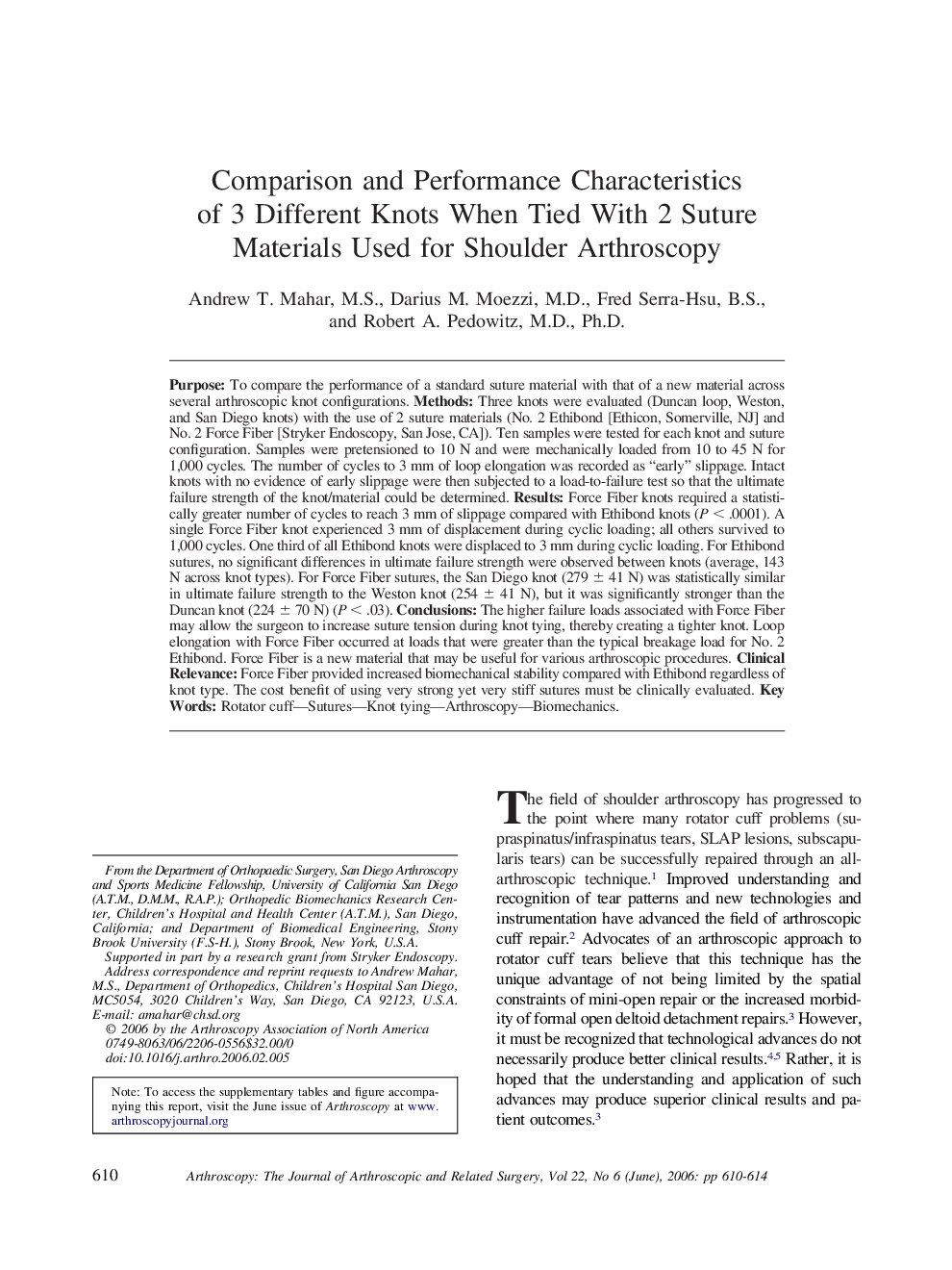| کد مقاله | کد نشریه | سال انتشار | مقاله انگلیسی | نسخه تمام متن |
|---|---|---|---|---|
| 4047741 | 1603609 | 2006 | 7 صفحه PDF | دانلود رایگان |
عنوان انگلیسی مقاله ISI
Comparison and Performance Characteristics of 3 Different Knots When Tied With 2 Suture Materials Used for Shoulder Arthroscopy
دانلود مقاله + سفارش ترجمه
دانلود مقاله ISI انگلیسی
رایگان برای ایرانیان
کلمات کلیدی
موضوعات مرتبط
علوم پزشکی و سلامت
پزشکی و دندانپزشکی
ارتوپدی، پزشکی ورزشی و توانبخشی
پیش نمایش صفحه اول مقاله

چکیده انگلیسی
Purpose: To compare the performance of a standard suture material with that of a new material across several arthroscopic knot configurations. Methods: Three knots were evaluated (Duncan loop, Weston, and San Diego knots) with the use of 2 suture materials (No. 2 Ethibond [Ethicon, Somerville, NJ] and No. 2 Force Fiber [Stryker Endoscopy, San Jose, CA]). Ten samples were tested for each knot and suture configuration. Samples were pretensioned to 10 N and were mechanically loaded from 10 to 45 N for 1,000 cycles. The number of cycles to 3 mm of loop elongation was recorded as “early” slippage. Intact knots with no evidence of early slippage were then subjected to a load-to-failure test so that the ultimate failure strength of the knot/material could be determined. Results: Force Fiber knots required a statistically greater number of cycles to reach 3 mm of slippage compared with Ethibond knots (P < .0001). A single Force Fiber knot experienced 3 mm of displacement during cyclic loading; all others survived to 1,000 cycles. One third of all Ethibond knots were displaced to 3 mm during cyclic loading. For Ethibond sutures, no significant differences in ultimate failure strength were observed between knots (average, 143 N across knot types). For Force Fiber sutures, the San Diego knot (279 ± 41 N) was statistically similar in ultimate failure strength to the Weston knot (254 ± 41 N), but it was significantly stronger than the Duncan knot (224 ± 70 N) (P < .03). Conclusions: The higher failure loads associated with Force Fiber may allow the surgeon to increase suture tension during knot tying, thereby creating a tighter knot. Loop elongation with Force Fiber occurred at loads that were greater than the typical breakage load for No. 2 Ethibond. Force Fiber is a new material that may be useful for various arthroscopic procedures. Clinical Relevance: Force Fiber provided increased biomechanical stability compared with Ethibond regardless of knot type. The cost benefit of using very strong yet very stiff sutures must be clinically evaluated.
ناشر
Database: Elsevier - ScienceDirect (ساینس دایرکت)
Journal: Arthroscopy: The Journal of Arthroscopic & Related Surgery - Volume 22, Issue 6, June 2006, Pages 610-614.e2
Journal: Arthroscopy: The Journal of Arthroscopic & Related Surgery - Volume 22, Issue 6, June 2006, Pages 610-614.e2
نویسندگان
Andrew T. M.S., Darius M. M.D., Fred B.S., Robert A. M.D., Ph.D.,